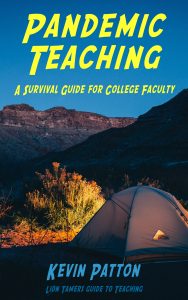| Lion practice. http://lion8.us/g0KOX5 |
One of the most engaging ways to facilitate active, fun practice in the classroom involves the use of student response systems (clickers). I've written about my use of clickers in my other blog The Electronic Professor. Although the first generation of such systems were difficult to use, the current systems are as easy as pie and extremely reliable.
In my anatomy and physiology courses, which are rigorous courses that serve as a foundation for all of the health-related careers, I have found clickers to be a wonderful tool for practicing problem-solving. My online tests and in-class exams are chock-full of case studies and other applications that require the ability to analyze situations, apply concepts, and solve problems. As you can imagine, students struggle with these items. At least at first. When I introduce an example of one of the trickier problems that students will encounter on a test as an in-class clicker question, it allows them to practice solving it is a group. And with me there to help.
Often, the graph showing how students have answered the item tells me that most, if not all, of them have failed to answer it correctly. That's because I try to choose the type of question that I know from past experience students give my students trouble. So when the results of the clicker poll are revealed, I can tell them that they've missed the mark and then ask them to try and figure out what went wrong.
With some leading questions, I can usually coax the correct response out of them. I usually only after some discussion and some group practice in analyzing the situation and applying concepts effectively. This way, they get a chance to make a mistake without penalty and completely anonymously.
And they get a chance to collaborate on fixing the mistake. In doing so, they are practicing the skills needed to solve such problems. And they are reviewing the concepts needed to apply to the problem situation. My coaching helps them learn where to start in solving a problem and what steps to take to get to a solution.
In a brief supplement course that accompanies my anatomy and physiology courses, we use the clickers to do another kind of practice. This one is more like a traditional drill. But not quite the boring rote learning of days gone by.
One of the things that my students really struggle with is how to identify anatomical structures in dissected specimens, models, and charts. They know that they will be tested in a so-called "practical" exam. That is, they will be given a specimen and asked to identify which structure is which. In other words, they have to be certain that they have found the right structures, they have to memorize a large number of these structures' locations and characteristics, and they have to be able to apply this knowledge at a moments notice in the presence of the lab instructor. Not having had much if any experience with this type of learning and testing, and being faced with an overwhelming number of such concepts to learn and apply, they struggle.
So what I do in my supplement class is let them practice on paper first. That is, they do "virtual" dissections of photographs. Then they go to their lab course and do the actual dissections. After that, they come back to the supplement course where I give them examples of what they will see on their practical exam. But instead of answering individually, they use the clickers to answer all at once. And anonymously. I reveal the graph of results from the clicker poll and we see how many people were successful in correctly identifying a particular structure.
If most people in the class were successful, then I either move on to the next item or a briefly remind them of the identifying characteristics of the structure to reinforce what they at least tentatively already knew. If a significant number of students were unsuccessful, then I can ask some pointed questions that will lead toward the correct response. This allows me to give them some additional tips on how to locate and identify structures. Such tips would likely fall on deaf ears at the beginning of the lesson. Learning such tips immediately after failing to identify a particular anatomical structure shows the student hi useful they really are.
I usually set up these drills in a sort of game show format with the timer and buzzer so that the students have to respond immediately, as they would during the practical exam. And like a game show, they seem to really get into it and cheer when they nail it (or groan when they miss it). Because the system allows them to remain anonymous, they are not afraid to make a stab at each answer. They can make their mistakes during our drill and not in a practical exam. By having a large number of such items, many of which show up in more than one drill, they get in a lot of practice, practice, practice.
Do you have some other ideas for effective practice of course concepts and skills? If so, I'd love to hear about them!


No comments:
Post a Comment